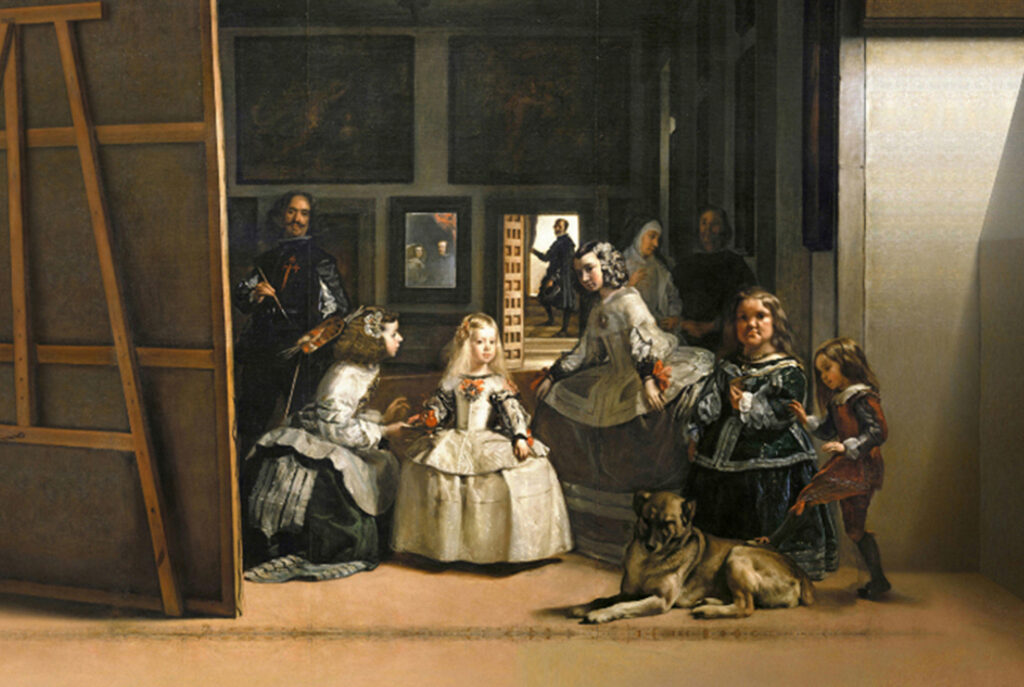
Who is Diego Velazquez?
Who is Diego Velazquez? Why is Velazquez important? Where can I see Velazquez arworks? What are 5 facts about Diego Velazquez? These are some of the topics we are going to cover in this blog post dedicated to one of the GOATs of Art History.
- Who is Diego Velázquez?
- 5 Facts About Diego Velázquez
- 3 Must-See Masterpieces by Velázquez
- Where can I see Velazquez artworks?

Who is Diego Velazquez?
Diego Velázquez wasn’t just a painter—he was a royal visionary with a brush. Born in 1599 in Seville, Spain, he quickly rose from a talented young artist to the court painter of King Philip IV, redefining what portraiture could be.
Velázquez didn’t believe in painting people as mere symbols—he believed in capturing their humanity. His works shimmer with realism, psychological depth, and a technical mastery that inspired everyone from Goya to Picasso to the Impressionists. Portraitist, historical painter, innovator—he was a one-man revolution in Baroque art.
In short: Velázquez didn’t just depict the Spanish Golden Age. He made it unforgettable.
“I would rather be the first painter of common things than second in higher art” – Quote by Diego Velazquez
5 Facts about Diego Velazquez
1. He started young.
By the time he was 18, Velázquez had already opened his own studio in Seville. Talk about an early career launch.
2. He was the king’s favorite.
King Philip IV trusted Velázquez so much that he not only painted the royal family but also served as a court official and curator.
3. Las Meninas inspired generations.
Picasso himself created over 50 interpretations of Velázquez’s masterpiece “Las Meninas,” calling it a “painter’s painting.”
4. He traveled to Italy—twice.
Velázquez journeyed to Italy to study Renaissance masters, bringing back techniques that transformed Spanish painting.
5. He painted the Pope.
Velázquez painted Pope Innocent X in a portrait so lifelike that the Pope supposedly exclaimed, “È troppo vero!” (“It’s too true!”)
What are the important artworks by Velazquez?

1. Las Meninas (1656)
A mysterious, multilayered portrait of the royal family, with Velázquez himself painting within the painting. This isn’t just a picture—it’s an exploration of reality and perception.

2. The Surrender of Breda (1635)
A monumental historical scene showing respect between victors and the defeated—a masterclass in narrative and humanity.

3. Portrait of Innocent X (1650)
A haunting, vivid portrayal of power and unease. Francis Bacon later reimagined it in his own iconic “Screaming Popes” series.

Francis Bacon – Screaming Pope
Where can I see Velazquez Artworks?

If you want to truly understand the man behind the masterpieces, head to the Prado Museum in Madrid. It holds the largest collection of Velázquez’s paintings in the world, from court portraits to mythological scenes.
Velázquez Palace (Palacio de Velázquez)
Nestled in Madrid’s Retiro Park, this beautiful 19th-century exhibition space bears his name and often hosts art shows that honor his legacy.
Several of Velázquez’s royal portraits still adorn the halls of this opulent palace, reminding visitors of his role as the king’s chronicler.
Velázquez Statue at the Prado Museum
Right outside the Prado stands his statue—paintbrush in hand—greeting visitors who come to see the world’s greatest collection of his works.
A final brushstroke
Velázquez wasn’t afraid to show reality—in fact, he embraced it with dazzling honesty. He painted kings and commoners with equal humanity, defied conventions, and changed European art forever.
Was he innovative? Absolutely. Was he revered? Without question. But was he one of the greatest painters to ever live? Unquestionably.
From royal portraits to timeless masterpieces, Velázquez’s work still captivates the art world, one brushstroke at a time.
If you love art… check out our Street Art and Art Gallery Tours in Madrid
At Artspace Tours we are on a mission to connect curious travellers with the local art scene. We are based in Barcelona and have expanded to Madrid. Check out our tour offer here.
If you like this post, check out our post about the painter Joan Miró here.
